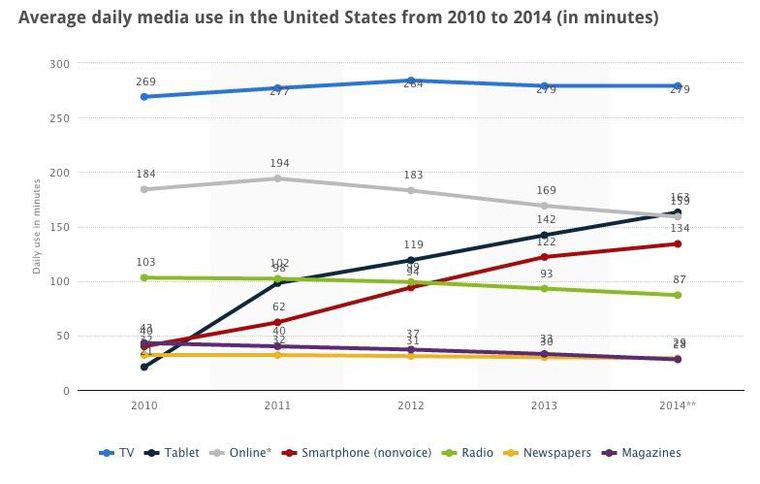
I can’t remember the last time I listened to the radio.
Ever since I upgraded to a smartphone, whenever I’ve traveled anywhere, I’ve streamed music from my iTunes or from Spotify. At home, my parents listen to Pandora on a constant loop. My brother is always plugged into his iPod and my friends are always streaming 8tracks. In my world, it seems traditional AM/FM radio has become a thing of the past.
In a world more connected than ever before, radio stations are transitioning online as well. Countless online radio sites debuted (i.e. TuneIn, Xiialive, Songza, 8tracks, IHeartRadio, Slacker, iTunes Radio, Spotify, and Pandora) , along with an ever increasing amount of radio streaming apps. Traditional AM/FM radio is still around, but with a dwindling audience. The graph below, from online statistic site Statista, shows the average daily media use in the US over the past four years. Radio usage, represented by the green trend line, has been steadily declining.

Could radio be on the way out?
There are some signs that indicate, yes, maybe it could be.
A study on Mobile Usage Trends from January of this year indicates 20% of smartphone users now listen to internet radio on their mobile devices. With the consideration that internet radio and apps are still relatively new, this can be deemed a notable change in demographics – one in five smartphone users now listen primarily to internet radio.
A different study focusing on In-Car Internet Audio listening, indicated a similar trend, with 26% of all mobile phone owners having connected their phones to a car audio system to listen to online radio in 2013, with about a 25% increase year-over-year since 2010. The statistics aren’t yet in for 2014, but if they follow the trend of the past four years, the number will be up to 33%.
So what does this mean for radio?
There’s no question about it – we are making a transition to all things digital.
Radio, books, newspapers and magazines are all moving towards refined digital presentations. This doesn’t necessarily mean radio, or any other medium listed, is on its way out.
According to the 10th annual Tech survey by Jacobs Media, “Almost one-fifth of weekly radio usage in the US…now occurs on digital sources”. However, only 16% of those surveyed believe good old AM/FM radio will eventually be replaced by any digital media platforms.
If you think about it, this makes sense. Not everyone has a smartphone or reliable access to the internet. While there has been an enormous increase in overall accessibility, the reality is that technology is still very much a luxury, not a standard. Things like the radio, printed books, and newspapers will still be around for years to come because, for a lot of people, they’re the easiest and most affordable ways of getting information.
Nevertheless, we will see an increase in digital media platforms in the coming years. To those who are capable of using them, there are definite benefits. You can listen to music catered to your own tastes, skip or change the songs you don’t like, and for the most part, avoid the majority of advertisements.
Traditional AM/FM radio will still be around. But to those who have accessibility, there will be a better option, and therefore AM/FM radio listeners will dwindle away.
Regardless, whether it be on AM/FM radio, or the internet:



